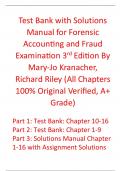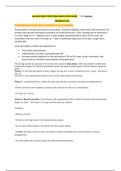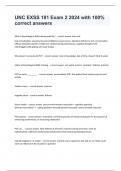Test Bank with Solutions
Manual for Forensic
Accoun�ng and Fraud
Examina�on 3rd Edi�on By
Mary-Jo Kranacher,
Richard Riley (All Chapters
100% Original Verified, A+
Grade)
Part 1: Test Bank: Chapter 10-16
Part 2: Test Bank: Chapter 1-9
Part 3: Solutions Manual Chapter
1-16 with Assignment Solutions
,Test bank project for Forensic Accounting and Fraud Examination (3rd Ed.) by Mary-Jo Kranacher and
Dick Riley
Test bank written by Brian L. Carpenter, , ∙ . ∙ .
CHAPTER 10
1. In the fraud examination and forensic accounting professions, nothing is more important
to the successful resolution of a case than the ability to conduct thorough interviews of
____________ and interrogation of ________________________.
A. Subjects and targets; witnesses
B. Employees and board members; fraudsters
C. Witnesses; subjects and targets
D. Fraudsters; felons
2. _____________ is the systematic questioning of a person who has knowledge of events,
people, evidence, and other details surrounding a fraud or forensic accounting issue.
A. Interrogating
B. Interviewing
C. Canvassing
D. Structured dialoguing
3. _____________ generally involves the questioning of a suspect, target, or uncooperative
witness to obtain evidence, to obtain an admission of guilt or complicity in an act, or to
give the interviewee an opportunity to volunteer facts and circumstances that may
eliminate them as a suspect or target of the examination.
A. Interviewing
B. Examination
C. Interrogation
D. Instigation
4. In a fraud examination, evidence is usually gathered in a manner that moves from
__________ to __________.
A. Facts; hypothesis
B. Hypothesis; facts
C. Specific; general
D. General; specific
5. By arranging interviews in order of probable culpability, the fraud examiner is in a
position to ______________________________________.
A. Have as much information as possible by the time the prime target is interviewed
B. Save the time and cost of depositions until last for the most probable targets
C. Use lawful threats (e.g., jail, conviction, fines) for uncooperative suspects
D. Seek any additional grand jury indictments needed based on the evidence gathered
6. Under which kind of fraud would an examiner start with the suspected perpetrator?
1 of
9
,Test bank project for Forensic Accounting and Fraud Examination (3rd Ed.) by Mary-Jo Kranacher and
Dick Riley
Test bank written by Brian L. Carpenter, , ∙ . ∙ .
A. Cases of collusion where a co-conspirator agrees to testify against the perpetrator
B. Fraudulent representations (such as tax returns and financial statements)
C. Almost every instance where the suspected perpetrator has a prior fraud conviction
D. If surveillance footage contains “smoking gun” evidence against the perpetrator
7. You are a fraud examiner who has been hired to investigate a potential embezzlement
case. In which order should you go about gathering the evidence?
A. Document analysis, neutral third-party witnesses, co-conspirator(s), corroborative
witnesses, target.
B. Target, co-conspirator(s), corroborative witnesses, document analysis, neutral third-
party witnesses.
C. Document analysis, neutral third-party witnesses, corroborative witnesses, co-
conspirator(s), target.
D. Target, co-conspirator(s), corroborative witnesses, neutral third-party witnesses,
document analysis.
8. Many anti-fraud professionals, forensic accountants, and attorneys will suggest that the
outcome of an interview or interrogation may be determined before the first question is
asked. What is the underlying belief to this maxim ?
A. If you position yourself as an expert, witnesses will generally be reluctant to lie.
B. Professional experience trumps attempts at concealment in most frauds.
C. Eyewitness testimony is reasonably reliable.
D. Preparation is the primary key to success.
9. You are a fraud examiner investigating the theft of a company’s automotive parts
inventory. After reviewing documents and interviewing witnesses, you have narrowed the
list of probable perpetrators to three warehouse workers who appear to have colluded with
each other: a forklift operator, a shift leader, and a loader. All three have high school
diplomas and earn about 15% more than minimum wage (except for the shift leader, who
earns a little more). You decide to interview the forklift driver first (on the belief that the
shift leader and the loader are the probable primary targets). As you talk, you use the
terms, “collusion,” “defalcation,” and “predication.” Which of the following statements is
most applicable?
A. You should use technical terms and language whenever possible as a power
dynamic to persuade witnesses into cooperating with you.
B. You should avoid technical terms and language because they may confuse the
interviewee.
C. You should use technical terms and language frequently, especially with people not
trained in accounting or forensics because it may prompt them to confess sooner
because they tend to assume you know what you are doing.
D. You should avoid technical terms and language because it may cause the
interviewee to want to play “one-upmanship” games with you.
2 of
9
, Test bank project for Forensic Accounting and Fraud Examination (3rd Ed.) by Mary-Jo Kranacher and
Dick Riley
Test bank written by Brian L. Carpenter, , ∙ . ∙ .
10. One consideration for conducting good interviews includes keeping questions to the point.
Which of the following considerations is not recommended:
A. Avoiding leader questions that suggest a specific answer
B. Encouraging the interview to speculate in the absence of underlying evidence
C. Discouraging the interviewee from getting off-subject
D. Keeping questions reasonably short.
11. Instead of taking detailed notes during an interview, the authors advise jotting down
keywords. The reason they recommend this is that:
A. Taking extensive notes distracts interviewers from their main responsibility to
watch and listen.
B. Taking extensive notes tends to make witnesses uncomfortable which may cause
them to be less forthcoming.
C. Taking extensive notes allows the opposing side to obtain them during discovery
which may reveal your side’s strategy.
D. Taking extensive notes is impractical and will cause interviews to last unnecessarily
long, thereby fatiguing both the examiners and witnesses.
12. Interviewers need to have complete command of the facts, events, dates, other relevant
details, especially in potentially adversarial interviews, in order to
_____________________________________.
A. Appear to not be caught off guard by previously unknown information
B. Present a professional image that establishes the authority of the interviewer
C. Focus on more granular details that would likely be known only by the subject or
target
D. Deflate attempts at misdirection and deception by the subject or target
13. One issue that arises in interviews is the use of checklists and pre-written questionnaires.
The main benefit of these is that the interviewer will be well prepared and less likely to
miss an important inquiry. However, checklists can _________________.
A. Be subpoenaed by opposing counsel which may give it information it didn’t have
B. Create tunnel vision and distract the interviewer from looking for signs of
deception
C. Cause the interviewer to lose credibility with the witness because they make the
interviewer look like they don’t know what they’re doing
D. Inadvertently divulge to a witness critical information known to the interviewer
14. In a typical interview, at what stage would the question be asked, “Is there anyone else I
should speak with about the matter?”
A. The close
3 of
9







